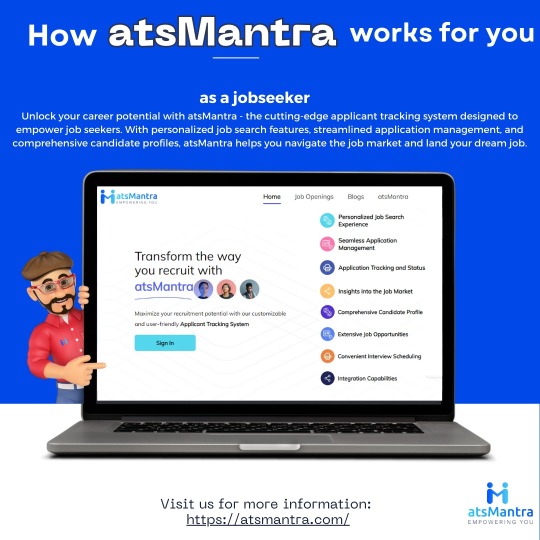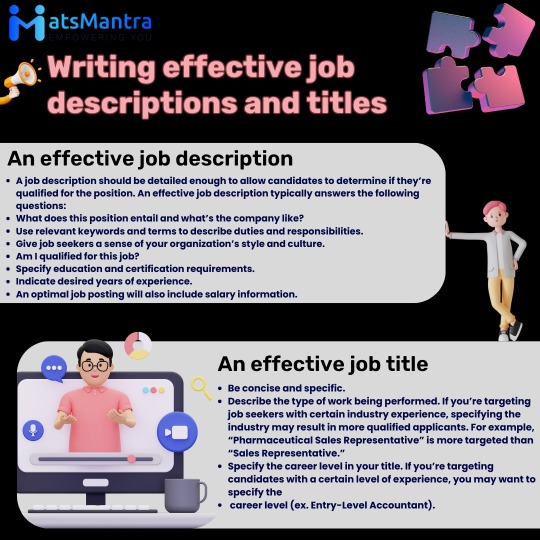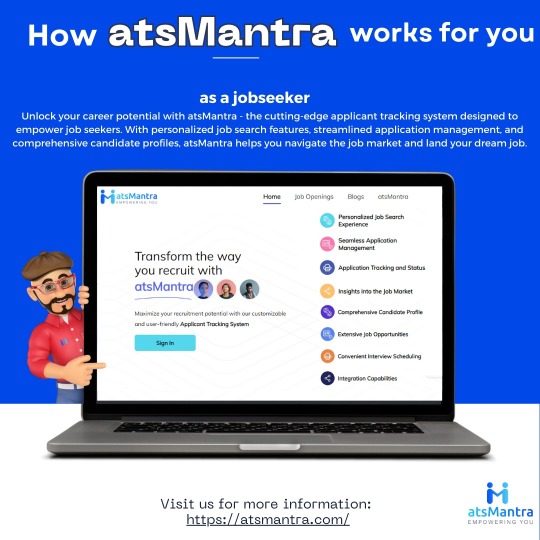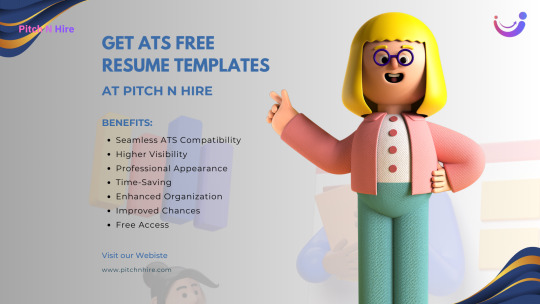#Applicant Tracking System
Explore tagged Tumblr posts
Note
Hi bitches! I just wanted to share some advice on resume construction that I just discovered. Turns out ATS softwares (the program that decides if your resume is any worth) can't read information in tables! Or outside of a 1" margin space. There's some ATS scanners online you can use to check your resume out.
It shouldn't be creative either, apparently, I'm just going to ditch my current format and use a template that is ATS approved 😅
This is unfortunate to find out after 99 applications that I'm seemingly pretty qualified for, especially since everyone I show it to says my resume is one of the best they've seen. Here's to 99 more!
For the uninitiated, ATS stands for "applicant tracking system," and it's the software lots of companies use to screen job applications for keywords and the like.
This is fantastic advice, sweet pea! Thank you for sharing with the whole class and helping others learn from your experience.
How to Write a Resume so You Actually Have a Prayer of Getting Hired
129 notes
·
View notes
Text
How to Get a Job: Top Tips to Land Your Next Role

Landing a job can feel like navigating a maze—exciting but often challenging. In today’s competitive job market, it’s not just about finding any job; it’s about finding the right job that aligns with your skills and career goals. The good news? With the right preparation and strategy, you can significantly increase your chances of landing your dream role. In this guide, we’ll walk you through some of the top tips to help you stand out and secure your next job.
Self-Assessment Before you dive into job applications, take a step back and do a little self-reflection. Knowing what you’re good at and where you need improvement is crucial. Identify Your Strengths and Weaknesses: Start by listing your key skills and experiences. What are you really good at? Where do you shine in your current or past roles? At the same time, be honest about areas where you could improve. Understanding these aspects of yourself will help you apply for roles that truly match your capabilities. Set Clear Career Goals: What do you want from your next job? Is it a step up in your current career path, a shift into a new industry, or maybe a role with a better work-life balance? Clearly defining your goals will help you focus your job search on positions that align with your aspirations. Tailoring Your Job Search: Instead of applying to every job you come across, focus on those that match your skills and goals. This targeted approach will not only save you time but also increase your chances of landing a job that’s a good fit for you.
Resume and Cover Letter Preparation Your resume and cover letter are often the first impression you make on a potential employer. Make sure they represent you well.
Crafting a Standout Resume: Your resume should be clear, concise, and focused on your achievements. Use bullet points to highlight your key responsibilities and accomplishments in previous roles. Make sure your resume is easy to read and free of any clutter or unnecessary information.
Personalizing Your Cover Letter: A generic cover letter won’t do you any favours. Take the time to tailor each cover letter to the specific job and company. Mention the company’s name, the role you’re applying for, and why you’re excited about the opportunity. Show them you’ve done your homework and are genuinely interested in the position.
Showcasing Achievements and Skills: Don’t just list your job duties—highlight your achievements. Did you exceed sales targets? Streamline a process? Lead a successful project? Make sure these accomplishments are front and centre on your resumes 3. Job Search Strategies The job search process has evolved, and there are more tools than ever to help you find opportunities. Here’s how to make the most of them.
Utilizing Online Job Portals: Websites like LinkedIn, Indeed, and Glassdoor are excellent resources for finding job openings. Set up job alerts to be notified when positions that match your criteria are posted. Also, make sure your LinkedIn profile is up to date, as many recruiters use the platform to find candidates.
Networking: Never underestimate the power of networking. Many jobs aren’t advertised publicly, so having a strong network can give you access to these hidden opportunities. Reach out to former colleagues, attend industry events, and engage with professionals in your field online.
Company Research: Take the time to research companies that interest you. What’s their culture like? What are their values? By understanding more about a company, you can tailor your application to align with what they’re looking for and stand out as a candidate. 4. Acing the Interview Getting an interview is a big step, but it’s just the beginning. Now it’s time to show them why you’re the best fit for the role.
Preparation is Key: Before the interview, research the company thoroughly. Understand their products, services, culture, and recent news. Practice answering common interview questions, and prepare examples that showcase your skills and experience. Dressing appropriately is also important—when in doubt, it’s better to be slightly overdressed than underdressed.
Showcasing Your Skills: During the interview, be clear about what you bring to the table. Use specific examples from your past experience to demonstrate how you’ve successfully handled similar tasks or challenges. Remember, it’s not just about what you’ve done, but how it’s relevant to the role you’re applying for.
Asking the Right Questions: An interview is a two-way street. Prepare a few thoughtful questions to ask the interviewer. This shows that you’re genuinely interested in the role and helps you gather important information about whether the company is the right fit for you. 5. Follow-Up After the interview, don’t just sit back and wait. Taking a few extra steps can make a big difference.
Sending a Thank-You Note: A simple thank-you email can go a long way. Express your appreciation for the opportunity to interview, reiterate your interest in the role, and briefly mention why you believe you’re a great fit. It’s a small gesture that can leave a positive impression.
Staying in Touch: If you don’t hear back right away, don’t panic. It’s okay to send a polite follow-up email after a week or so. This keeps you on the employer’s radar without being too pushy. 6. Handling Rejection Rejection is a normal part of the job search process, but it doesn’t make it any less disappointing. Here’s how to handle it constructively.
Keeping a Positive Mindset: It’s easy to get discouraged, but try to stay positive. Every “no” is one step closer to a “yes.” Keep reminding yourself that the right opportunity is out there, and you just need to keep moving forward.
Learning from Feedback: If you’re fortunate enough to receive feedback after a rejection, use it to your advantage. Reflect on what you could improve and apply those lessons to your next application or interview.
Staying Persistent: The job search can be a long process, but persistence pays off. Keep applying, keep refining your approach, and eventually, you’ll land the right role. Conclusion Job searching can be tough, but by following these tips, you’ll be better equipped to navigate the process and find a role that’s a great fit for you. Remember, it’s all about preparation, persistence, and maintaining a positive mindset. Keep pushing forward, and don’t hesitate to ask for help or advice along the way. Good luck with your job search—you’ve got this!
#applicant tracking software#applicant tracking system#hiring#hiring and recruiting#jobs#job#job applications
6 notes
·
View notes
Text
“The conclusion can be extended that the true purpose of reCAPTCHA v2 is a free image-labeling labor and tracking cookie farm for advertising and data profit masquerading as a security service.”
https://www.theregister.com/2024/07/24/googles_recaptchav2_labor/
#google maps#google#recaptcha#applicant tracking system#tracking#data privacy#online privacy#internet privacy#privacy#invasion of privacy#advertisements#advertising#marketing#ausgov#politas#auspol#tasgov#taspol#australia#fuck neoliberals#neoliberal capitalism#anthony albanese#albanese government
3 notes
·
View notes
Text
Best Applicant Software for Hiring in 2024
Applicant Tracking Systems (ATS) systems assist in aggregating and arranging job applications. It streamlines recruitment processes and secures the ideal fit for your company.
An effective ATS simplifies the hiring process, saving time and resources. Improved sourcing, efficient processes, and customizable features such as career sites, job board distribution, candidate correspondence and more can aid in discovering top talent at a faster pace.
In this article, we delve into the top ATS applications that aid managers globally in locating the perfect candidate for their job opening.
How Does Applicant Software Hire?
The functioning of Applicant Software can be broken down into 4 fundamental steps:
A job requisition is entered into the ATS, providing details such as the job title, sought-after skills, and necessary experience.
The ATS takes this information and formulates a candidate profile that serves as a benchmark.
As resumes pour in, the ATS categorizes, orders, and evaluates them in accordance with the candidate profile.
Hiring managers can effortlessly spot the most competent candidates and advance them to the next stage of the hiring process.

Best Applicant Software for Hiring is atsMantra
We’ve come up with these Best Applicant Software for Hiring that will help you make the best decision on what to use for your organization.
RecruitHire
Streamline your recruitment process with RecruitHire. Upload, import, and review candidate profiles effortlessly. Stay up-to-date on their status and easily gather the necessary data to manage their applications. Job management is made simple, allowing you to:
Create new job listings
Filter applicants
Monitor their status
Activate or deactivate job openings with a click https://atsmantra.com/

3 notes
·
View notes
Text
Why should I use an ATS in recruiting?
As the previous scenario illustrates, using a streamlined ATS in recruiting delivers many benefits:
It saves time. Not only does an ATS make your applicant pool easily accessible in an organised, searchable database, it also includes features that automate manual tasks. This frees recruiters to spend more time on high-value activities, like personalised outreach and relationship-building.
It helps you recruit more effectively. Collaborating and communicating with your talent organisation is easier with a centralised applicant tracking system. Robust analytics show your hiring team which sources are most fruitful, how long applicants take to move through the pipeline and other insightful metrics that can make your recruiting process even more effective.
It improves the candidate experience. An ATS allows you to stay on top of each applicant’s position in the recruitment process. This tracking minimizes the “black hole” — when candidates do not hear back from employers. CRM tools, a key component of your ATS, help recruiters follow up promptly and build relationships with clients.

3 notes
·
View notes
Text
What is an Applicant Tracking System?
An Applicant Tracking System is a software application companies can use to structure and customize their hiring into an efficient and scalable process. An ATS allows recruiters and hiring managers to attract, source, evaluate, and hire candidates better and faster.
What is the primary purpose of an Applicant Tracking System?
The primary goal of an Applicant Tracking System is to simplify the recruitment process and to make it more effective and efficient. This is accomplished by giving recruiters access to a powerful, centralized platform to collect and view applicants, track their progress, and filter them out based on their qualifications.
Generally, more powerful ATS platforms are cloud-based SaaS (Software as a Service) solutions, which you can access anywhere and anytime. The scope and complexity of specific ATS platforms and the cost will vary depending on what type of business it caters to. On-site and SaaS solutions will generally be more expensive but offer significantly more features and services than open-source options.
The three primary business types that an ATS serves are:
Enterprise-level companies
Recruitment agencies
Small or medium-sized businesses (SMBs)
2 notes
·
View notes
Text
A recruiter's complete guide to Applicant Tracking Systems
If you clicked on this article, it probably means you’re looking to learn about or better understand Applicant Tracking Systems (ATSs), or you’re in the market for one. Regardless of which it is, you’ve come to the right place. We’ve put together this guide to answer your burning questions about all things ATS and included insights from experts in the field.
Just a heads up, this is going to be a long (and good) read, so feel free to skip to the most relevant parts for you using our table of contents sidebar.
What is an Applicant Tracking System?
An Applicant Tracking System is a software application companies can use to structure and customize their hiring into an efficient and scalable process. An ATS allows recruiters and hiring managers to attract, source, evaluate, and hire candidates better and faster.
https://atsmantra.com

2 notes
·
View notes
Text
4 notes
·
View notes
Text
Tempted to become one of those LinkedIn influencers, but instead of telling overworked people to "work harder", I'm gonna challenge recruiters and CEOs into dropping their ATS scanners and actually go through every single applicant's CV and cover letter as a reading challenge.
Agree?
#LinkedIn#influencer#agree?#tedx talks#ATS#ATS scanner#applicant tracking system#make recruiting human again#recruiter#job recruiters#ai
4 notes
·
View notes
Text

Applicant tracking system is commonly used by human resources departments and staffing agencies to streamline and improve the hiring process. They can also be integrated with other HR software, such as performance management and onboarding systems, to provide a more comprehensive solution for managing the entire employee lifecycle.
2 notes
·
View notes
Text
How to Use ATS Systems to Get Noticed by Recruiters
Applicant Tracking Systems (ATS) have revolutionized the hiring process, making it easier for recruiters to filter through thousands of applications efficiently. If you want to increase your chances of getting noticed, understanding how ATS works and optimizing your resume accordingly is essential.
What is an ATS?
An ATS is a software application that automates the hiring process by scanning resumes, filtering candidates, and ranking them based on relevance to job descriptions. Recruiters use these systems to streamline hiring, making it crucial for job seekers to ensure their resumes align with ATS requirements.
For those looking to maximize their job search efforts, platforms like Find Jobs Online provide numerous opportunities to discover new openings and connect with recruiters.
Key Strategies to Optimize Your Resume for ATS
1. Use Relevant Keywords
ATS relies on keywords to assess the suitability of candidates. Ensure your resume includes industry-specific terms found in the job description, such as programming languages, certifications, or key responsibilities.
2. Maintain a Simple and Clean Format
Avoid complex layouts, graphics, and unusual fonts, as ATS systems may struggle to parse these elements. Stick to standard fonts like Arial or Times New Roman and use clear headings and bullet points.
3. Customize Your Resume for Each Job Application
A one-size-fits-all resume may not always work. Tailor your resume for each application by incorporating relevant keywords and focusing on skills and experiences that match the job posting.
4. Optimize Your Resume with Proper Headings
Use standard section headings like "Work Experience," "Education," and "Skills." This helps ATS easily navigate and categorize your resume correctly.
5. Avoid Unnecessary Information
Including irrelevant details like personal photos, fancy designs, or excessive personal information can reduce the ATS-friendliness of your resume. Stick to essential details that showcase your professional qualifications.
How to Improve Your Chances of Getting Noticed by Recruiters
1. Build a Strong Online Presence
Having a LinkedIn profile that complements your resume can boost your visibility. Recruiters often cross-check online profiles to validate the information provided in resumes.
2. Network with Industry Professionals
Engaging in networking events, joining professional groups, and connecting with recruiters on job portals can improve your chances of landing an interview.
3. Keep Your Resume Updated
Regularly updating your resume ensures that your latest achievements, skills, and experiences are included, making you a more attractive candidate to potential employers.
Common Mistakes to Avoid When Using ATS Systems
Overstuffing keywords in a way that disrupts readability.
Using images, charts, or tables that ATS may not interpret correctly.
Submitting resumes in non-standard formats like JPEG or PNG instead of PDF or DOCX.
Ignoring job description requirements when tailoring your resume.
Conclusion
Getting noticed by recruiters requires a strategic approach to resume optimization and job searching. By leveraging ATS best practices, utilizing job search platforms like ATSMantra, and continuously refining your skills, you can significantly increase your chances of landing your desired job. Stay proactive, network with professionals, and ensure your resume is ATS-friendly for the best results.
1 note
·
View note
Text
The Ultimate Guide to Creating ATS-Compatible Resumes with Pitch N Hire

In today's competitive job market, having an impressive resume is crucial. However, many job seekers are unaware that the most well-designed resumes can fall flat if they aren't compatible with Application Tracking Software (ATS). These systems are used by a vast majority of employers to filter resumes before they even reach human eyes. This is where Pitch N Hire comes in, offering specialized ATS-friendly resume templates that enhance your chances of landing your dream job.
What is ATS and Why is it Important? Application Tracking Software (ATS) is a tool used by recruiters and employers to streamline the hiring process. It scans resumes, searching for specific keywords and formats to rank candidates based on their relevance to the job. If your resume isn’t ATS-compatible, it might never make it to a hiring manager, no matter how qualified you are. This is why creating a resume that can seamlessly pass through these systems is essential.
How Pitch N Hire Helps You Create ATS-Compatible Resumes Pitch N Hire understands the challenges job seekers face with ATS and offers a suite of tools to ensure your resume meets these standards. Our platform provides ATS-friendly resume templates designed to be both visually appealing and functionally effective.
Here are the key benefits of using Pitch N Hire for your resume creation:
Seamless ATS Compatibility: Our resume templates are specifically designed to pass through ATS filters. This means no fancy graphics or complicated layouts—just clean, simple, and effective formatting that ATS systems can easily read.
Higher Visibility: By using an ATS-compatible resume, you increase your chances of getting noticed by recruiters. Pitch N Hire’s templates ensure that your resume reaches the top of the pile, giving you a competitive edge.
Professional Appearance: While ATS compatibility is crucial, so is making a great first impression. Our templates balance simplicity with professionalism, ensuring that your resume stands out for all the right reasons.
Time-Saving: With pre-designed templates, you can create a resume in minutes. This saves you the hassle of formatting and structuring, allowing you to focus on highlighting your skills and experiences.
Enhanced Organization: Our templates help you organize your information clearly and logically, making it easier for both ATS systems and recruiters to find the information they need quickly.
Improved Chances: By using a resume that is both ATS-friendly and professionally designed, you significantly improve your chances of landing interviews and, ultimately, job offers.
Free Access: One of the standout features of Pitch N Hire is that we offer free access to our ATS-compatible resume templates. This ensures that every job seeker has the tools they need to succeed, regardless of their budget. Why Choose Pitch N Hire? Pitch N Hire isn’t just another resume builder; it’s a comprehensive career partner. Our platform is designed with the modern job seeker in mind, offering tools and resources that go beyond just resume creation. Whether you’re new to the job market or an experienced professional, Pitch N Hire provides everything you need to make your job search more effective. By choosing Pitch N Hire, you're not only getting access to ATS-friendly resume templates but also joining a community that is dedicated to helping you succeed. From job search tips to interview preparation, we’re here to support you every step of the way. Conclusion In a world where first impressions count, having an ATS-compatible resume is more important than ever. With Pitch N Hire, you can easily create a resume that not only passes through Application Tracking Software but also captures the attention of hiring managers. Don’t leave your job search to chance—take control with Pitch N Hire and increase your chances of landing your dream job.
#applicant tracking software#hiring#hiring and recruiting#jobs#applicant tracking system#pitch n hire
5 notes
·
View notes
Text
Why Every Business Needs an Applicant Tracking System for Smarter Hiring

Hiring the right talent is crucial for any business, but the traditional recruitment process can be overwhelming. Sorting through resumes, keeping track of applications, scheduling interviews, and ensuring smooth communication between recruiters and candidates takes a lot of time and effort. If your hiring team is struggling with these challenges, it’s time to consider an applicant tracking system.
An ATS helps businesses automate and optimize their hiring process, ensuring that they find and hire the best candidates quickly and efficiently. Let’s explore why investing in applicant tracking software for recruiters is essential in today’s competitive job market.
What is an Applicant Tracking System (ATS Software)?
An applicant tracking system is a software tool that helps businesses manage the entire hiring process in one place. From posting job openings and screening resumes to scheduling interviews and tracking candidates’ progress, an ATS software simplifies and speeds up recruitment.
Many companies, including small businesses and large enterprises, use the best applicant tracking software to streamline hiring and make data-driven decisions. The system allows recruiters to automate repetitive tasks, improve collaboration, and ensure a smooth hiring experience for both HR teams and candidates.
How Does an Application Tracking System Help Recruiters?
An applicant tracking software for recruiters is designed to address the most common hiring challenges. Here’s how it benefits businesses:
Saves Time and Reduces Manual Work
Without an ATS, recruiters spend hours reviewing resumes, organizing applications, and manually updating spreadsheets. An ATS software automates these processes, saving valuable time and allowing HR teams to focus on engaging with the best candidates.
Improves Hiring Accuracy with Smart Filtering
One of the biggest challenges in hiring is filtering through hundreds of resumes to find qualified candidates. The best applicant tracking software comes with intelligent filtering features that automatically screen resumes based on predefined criteria, such as skills, experience, and qualifications.
Enhances Candidate Tracking and Communication
Keeping track of each candidate’s status can be difficult, especially for businesses handling multiple job openings. An applicant tracking system provides a centralized dashboard where recruiters can monitor applications, send automated emails, and manage interview scheduling seamlessly.
Boosts Collaboration Among HR Teams
Hiring isn’t just about recruiters—it involves HR managers, department heads, and sometimes even CEOs. An ATS software allows teams to collaborate by sharing candidate evaluations, leaving feedback, and making hiring decisions more efficiently.
Reduces Hiring Costs and Improves ROI
A slow or inefficient hiring process can be expensive. Companies that use applicant tracking software for recruiters report reduced hiring costs because they spend less time on administrative work and more time hiring the right people. Faster hiring also means fewer lost opportunities.
Why Choose the Best Applicant Tracking Software for Your Business?
With so many options available, choosing the best applicant tracking software can make a significant difference in your hiring success. Here are some key features to look for:
Automated Resume Screening – AI-powered filtering to shortlist the best candidates
Job Posting Management – Easy posting across multiple job boards
Customizable Recruitment Workflow – Tailor the hiring process to your company’s needs
Interview Scheduling – Integrated tools for hassle-free scheduling
Reporting and Analytics – Data-driven insights for better hiring decisions
When you invest in a high-quality application tracking system, you not only improve efficiency but also create a positive hiring experience for candidates.
Recommended Read: HRMS Solutions: 7 Ways To Help Your Business Grow In 2025
Final Words
The hiring process is evolving, and companies that rely on outdated recruitment methods may struggle to attract top talent. A modern applicant tracking system ensures that businesses can streamline recruitment, improve accuracy, and make better hiring decisions.
Whether you’re a small business or a growing enterprise, implementing applicant tracking software can transform the way you hire. With Logicspice’s ATS software, you can automate time-consuming tasks, improve team collaboration, and hire the best talent faster.
Looking for the best applicant tracking software? Discover how Logicspice can help you simplify your hiring process!
#application tracking system#applicant tracking system#ats tracking system#ats software#applicant tracking software#best applicant tracking software#applicant tracking software for recruiters
0 notes
Text
🚀 AI in Tech Recruitment: Where Are We Now? 🤖💡
Curious about how AI is transforming tech hiring? Our latest report dives into the State of AI Adoption in Recruitment—uncovering trends, challenges, and the future of AI-powered hiring.
🔍 Get the insights: https://www.zappyhire.com/resources/ebooks/state-of-ai-adoption-in-recruitment-in-the-tech-industry-report
#talentacquisition#hrtech#recruitment automation#automated video interviews#applicant tracking software#recruitmentstrategies#applicant tracking system#recruitment#hrinsights#recruitmenttips
0 notes
Text
The Interconnected Trio: HRIS, ATS, and Organizational Charts
In today's competitive job market, attracting and hiring top talent is critical for organizational success. An Applicant Tracking System (ATS) significantly streamlines the recruitment process by know more https://infomartianlogic.blogspot.com/2024/12/the-interconnected-trio-hris-ats-and.html

0 notes
Text
3 notes
·
View notes